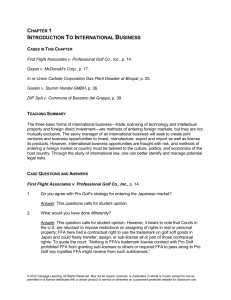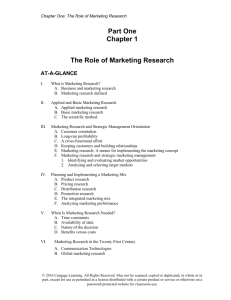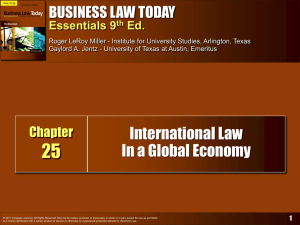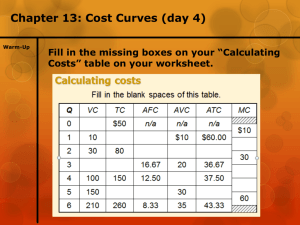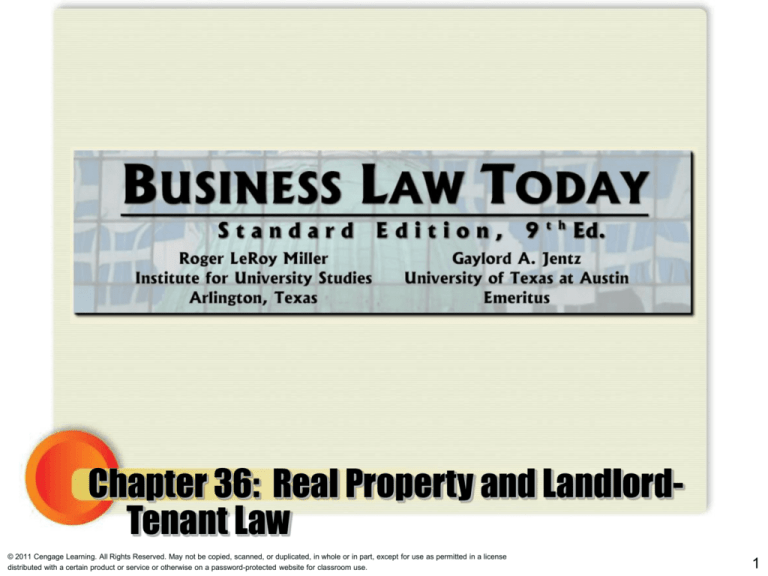
Chapter 36: Real Property and LandlordTenant Law
© 2011 Cengage Learning. All Rights Reserved. May not be copied, scanned, or duplicated, in whole or in part, except for use as permitted in a license
distributed with a certain product or service or otherwise on a password-protected website for classroom use.
1
Learning Objectives
• What can a person who holds property in fee
simple do with the property?
• What are the requirements for acquiring
property by adverse possession?
• What limitations may be imposed on rights of
property owners?
• What is a leasehold estate? What types of
leasehold estates, or tenancies, can be
created when real property is leased?
• What are the respective duties of the
landlord and tenant concerning the use and
maintenance of leased property?
© 2011 Cengage Learning. All Rights Reserved. May not be copied, scanned, or duplicated, in whole or in part, except for use as permitted in
a license distributed with a certain product or service or otherwise on a password-protected website for classroom use.
2
Nature of Real Property
• Real property is immovable and
includes:
– Land & Permanent Buildings.
– Airspace & Subsurface Rights.
– Plant Life and Vegetation.
– Subsurface (mineral) rights.
– Fixtures.
© 2011 Cengage Learning. All Rights Reserved. May not be copied, scanned, or duplicated, in whole or in part, except for use as permitted in
a license distributed with a certain product or service or otherwise on a password-protected website for classroom use.
3
Fixtures
• A fixture is personal property that
becomes permanently affixed to real
property.
– Intent that it become a fixture is necessary.
– Intent is determined by:
• The fact that the property cannot be
removed without causing damage to the
realty.
• The fact that the property is so adapted to
the realty that it has become part of the
realty.
© 2011 Cengage Learning. All Rights Reserved. May not be copied, scanned, or duplicated, in whole or in part, except for use as permitted in
a license distributed with a certain product or service or otherwise on a password-protected website for classroom use.
4
Trade Fixtures
• Trade fixtures: installed for commercial
purposes by a tenant.
• They remain the property of the tenant
and can be removed when tenant
leaves, repairing any damage caused
by removal.
© 2011 Cengage Learning. All Rights Reserved. May not be copied, scanned, or duplicated, in whole or in part, except for use as permitted in
a license distributed with a certain product or service or otherwise on a password-protected website for classroom use.
5
Ownership in Fee Simple
• The Fee Simple (sometimes called fee simple
absolute) gives the owner the greatest
aggregation of rights, powers and privileges
possible under American law and can
assigned to heirs.
– A “conveyance” (transfer of real estate) “from A to B”
creates a fee simple. A is the Grantor and B is the
Grantee.
Case 36.1 Biglane v. Under the Hill Corp.
Interference with owner’s quiet use and enjoyment of
his property must be “materially uncomfortable and
annoying.” Court fashioned an equitable remedy.
© 2011 Cengage Learning. All Rights Reserved. May not be copied, scanned, or duplicated, in whole or in part, except for use as permitted in
a license distributed with a certain product or service or otherwise on a password-protected website for classroom use.
6
Life Estates
• Estate that lasts for the life of some specified
individual. “A grants Blackacre to B for B’s
life” grants B a life estate in Blackacre.
• When B dies, Blackacre returns to A or his
heirs or assigns, or a third party in the same
condition, normal wear and tear excepted.
• Grantor A retains a “future interest” in the
property.
• During B’s life, she can possess, use, and
take the fruits of the estate, but not take from
the property itself.
© 2011 Cengage Learning. All Rights Reserved. May not be copied, scanned, or duplicated, in whole or in part, except for use as permitted in
a license distributed with a certain product or service or otherwise on a password-protected website for classroom use.
7
Nonpossessory Interests
• An easement is a right of a person to make
limited use of another person's real property
without taking anything from the property.
• A profit is the right to go onto land in
possession of another and take away some
part of the land itself or some product of the
land.
• Property that is benefited by easement/profit
carries the the interest with the sale of land.
© 2011 Cengage Learning. All Rights Reserved. May not be copied, scanned, or duplicated, in whole or in part, except for use as permitted in
a license distributed with a certain product or service or otherwise on a password-protected website for classroom use.
8
Appurtenant vs. Gross
• If the owner of the
easement (A) or profit
has the right to go onto
another’s land (B) that
is adjacent to A’s own, it
is said to be
appurtenant.
• If A’s property is
physically separated
from B’s, it is said to be
in gross.
© 2011 Cengage Learning. All Rights Reserved. May not be copied, scanned, or duplicated, in whole or in part, except for use as permitted in
a license distributed with a certain product or service or otherwise on a password-protected website for classroom use.
Appurtenant
A
B
In Gross
A
B
9
Creation of an Easement or Profit
• Easements or profits can be created
by:
– Deed (physical delivery is sufficient).
– Will (at Grantor’s death).
– Contract between Grantor and Grantee.
– Implication: circumstances surrounding
creation of easement imply its creation.
– Necessity.
– Prescription: easement by adverse
possession.
© 2011 Cengage Learning. All Rights Reserved. May not be copied, scanned, or duplicated, in whole or in part, except for use as permitted in
a license distributed with a certain product or service or otherwise on a password-protected website for classroom use.
10
Termination of an Easement or Profit
• By deed back to owner of the land
burdened by it.
• Owner of easement or profit becomes
owner of the land burdened with it.
• Abandonment by the owner of the
right.
© 2011 Cengage Learning. All Rights Reserved. May not be copied, scanned, or duplicated, in whole or in part, except for use as permitted in
a license distributed with a certain product or service or otherwise on a password-protected website for classroom use.
11
License
• Revocable right of a person to come
unto another’s land without removing
anything from the land.
• Personal privilege that arises from the
consent of the owner of the land that
can be revoked.
Case 36.2 Roman Catholic Church of our Lady
of Sorrows v. Prince Realty Management, LLC
. to install temporary plywood fence around
License
construction site, does not extend to more permanent
structures such as steel piles and beams.
© 2011 Cengage Learning. All Rights Reserved. May not be copied, scanned, or duplicated, in whole or in part, except for use as permitted in
a license distributed with a certain product or service or otherwise on a password-protected website for classroom use.
12
Transfer of Ownership
• Ownership in real property can be
transferred by:
– A written Deed.
– A Gift.
– A Sale.
– An Inheritance.
– Adverse Possession.
– Eminent Domain.
© 2011 Cengage Learning. All Rights Reserved. May not be copied, scanned, or duplicated, in whole or in part, except for use as permitted in
a license distributed with a certain product or service or otherwise on a password-protected website for classroom use.
13
Deeds
• A Deed is the instrument setting forth
the interests in real property being
transferred.
• Necessary components of a Deed:
– Names of Grantor and Grantee.
– Words evidencing intent to convey.
– Legally sufficient description of the land.
– Grantor’s signature.
– Delivery of the Deed.
© 2011 Cengage Learning. All Rights Reserved. May not be copied, scanned, or duplicated, in whole or in part, except for use as permitted in
a license distributed with a certain product or service or otherwise on a password-protected website for classroom use.
14
Types of Deeds
• Warranty Deed.
– Special Warranty Deed.
– Implied Warranties in New Homes.
• Quitclaim Deed.
• Grant Deed.
• Sheriff’s Deed.
– Period of redemption.
© 2011 Cengage Learning. All Rights Reserved. May not be copied, scanned, or duplicated, in whole or in part, except for use as permitted in
a license distributed with a certain product or service or otherwise on a password-protected website for classroom use.
15
Recording Statutes
• Recording a deed (or any interest in
real property) puts the public on notice
of the new owner’s interest in the land
and prevents the previous owner from
fraudulently conveying the same
interest to another buyer.
• Race statute.
– Pure notice statute.
– Notice-race statute.
© 2011 Cengage Learning. All Rights Reserved. May not be copied, scanned, or duplicated, in whole or in part, except for use as permitted in
a license distributed with a certain product or service or otherwise on a password-protected website for classroom use.
16
Will or Inheritance
• Owner of real property dies, his
property is transferred by:
– Will (testate).
– Without Will (intestate).
• Title is transferred at the time state law
so provides in its testate and intestate
laws.
© 2011 Cengage Learning. All Rights Reserved. May not be copied, scanned, or duplicated, in whole or in part, except for use as permitted in
a license distributed with a certain product or service or otherwise on a password-protected website for classroom use.
17
Adverse Possession
• One person possesses the property of
another for a certain statutory period of
time, that person automatically acquires
title to the land, just as if there had been
a conveyance by deed. Must be:
– Actual and exclusive.
– Open, visible and notorious.
– Continuous and peaceable.
– Hostile and adverse.
© 2011 Cengage Learning. All Rights Reserved. May not be copied, scanned, or duplicated, in whole or in part, except for use as permitted in
a license distributed with a certain product or service or otherwise on a password-protected website for classroom use.
18
Eminent Domain
• Rights in property are not absolute. They
are constrained by federal and state laws,
e.g., nuisance, tax and environmental.
• A “Taking” By Eminent Domain: The 5th
amendment gives the government the
right to “take” private land for public use
with just compensation.
Case 36.3
Drake v. Walton County.
Drakes reasonably relied on a stabilized drainage system
when they purchased property. When the county
permanently changed the drainage, a portion of Drake’s
property was taken without just compensation.
© 2011 Cengage Learning. All Rights Reserved. May not be copied, scanned, or duplicated, in whole or in part, except for use as permitted in
a license distributed with a certain product or service or otherwise on a password-protected website for classroom use.
19
Leasehold Estates
• Anyone who rents housing to the public
for commercial purposes subjects herself
to various state and federal LandlordTenant laws.
• Owner of the property is the LESSOR and
Tenant is LESSEE; the contract is called
the LEASE. The property interest is called
a leasehold estate.
© 2011 Cengage Learning. All Rights Reserved. May not be copied, scanned, or duplicated, in whole or in part, except for use as permitted in
a license distributed with a certain product or service or otherwise on a password-protected website for classroom use.
20
Tenancy Interests
• Tenancy for Years.
– Created by an express contract.
– Property is leased for a specified period of time.
• Periodic Tenancy.
– Does not specify how long lease lasts.
– But rent paid at certain intervals.
• Tenancy at Will.
– For as long as both agree.
• Tenancy at Sufferance.
– Wrongful possession without the right to
possess.
© 2011 Cengage Learning. All Rights Reserved. May not be copied, scanned, or duplicated, in whole or in part, except for use as permitted in
a license distributed with a certain product or service or otherwise on a password-protected website for classroom use.
21
Landlord-Tenant Relationships
• Lease Agreement can be oral or written
(oral may not be enforceable). Lease
gives Tenant the temporary right to
exclusively possess the property.
• Sources of Law:
– Common Law.
– State and Local Statutes, and
– The Uniform Residential Landlord and Tenant
Act (URLTA) which has been adopted by 1/4
of the states.
© 2011 Cengage Learning. All Rights Reserved. May not be copied, scanned, or duplicated, in whole or in part, except for use as permitted in
a license distributed with a certain product or service or otherwise on a password-protected website for classroom use.
22
Rights and Duties
• Trend in the law is to curtail, by
contract and real estate law, the
immense freedom that Landlords had
in the past.
– Possession.
– Using the Premises.
– Maintaining the Premises.
– Rent.
© 2011 Cengage Learning. All Rights Reserved. May not be copied, scanned, or duplicated, in whole or in part, except for use as permitted in
a license distributed with a certain product or service or otherwise on a password-protected website for classroom use.
23
Rights and Duties
• Landlord has a duty to deliver actual
physical possession under URLTA or
legal right to possession (“American”
rule).
– Tenant’s right to exclusive possession is only
subject to Landlord’s limited right to come unto
the property.
– Tenant has a “covenant of quiet enjoyment” by
which Landlord promises Tenant’s peace and
enjoyment of the property.
© 2011 Cengage Learning. All Rights Reserved. May not be copied, scanned, or duplicated, in whole or in part, except for use as permitted in
a license distributed with a certain product or service or otherwise on a password-protected website for classroom use.
24
Rights and Duties
• Eviction occurs when Landlord:
– Deprives Tenant of possession of the leased
property; or
– Interferes with this use or enjoyment of the
property to the extent that Tenant cannot use
or enjoy.
• Constructive eviction occurs when
Landlord:
– Breaches lease or covenant or quiet
enjoyment; and
– Makes it impossible for the Tenant to use and
enjoy the property.
© 2011 Cengage Learning. All Rights Reserved. May not be copied, scanned, or duplicated, in whole or in part, except for use as permitted in
a license distributed with a certain product or service or otherwise on a password-protected website for classroom use.
25
Implied Warranty of Habitability
• Implied Warranty of Habitability:
Landlord must furnish premises in
habitable condition.
– Landlord is responsible for maintaining
common areas such as stairs, parking lots,
elevators and swimming pools.
– Commercial property -- may still require
Tenant to maintain depending on the lease.
© 2011 Cengage Learning. All Rights Reserved. May not be copied, scanned, or duplicated, in whole or in part, except for use as permitted in
a license distributed with a certain product or service or otherwise on a password-protected website for classroom use.
26
Implied Warranty of Habitability
• To determine whether a breach has
occurred, courts consider:
– Whether Tenant caused damage.
– How long defect existed and age of building.
– Defects impact on Tenant’s safety and health.
– Whether defect contravenes relevant
statutes.
© 2011 Cengage Learning. All Rights Reserved. May not be copied, scanned, or duplicated, in whole or in part, except for use as permitted in
a license distributed with a certain product or service or otherwise on a password-protected website for classroom use.
27
Rent
• Rent is Tenant’s payment to the
Landlord for the Tenant’s occupancy or
use of the Landlord’s real property.
– Payment based on agreement, custom, state
statute, waiver.
• Security Deposits.
– A deposit by Tenant which Landlord may
retain for non-payment of rent or damage to
premises.
– URLTA has specific provisions as to when it
may be kept and when it must be returned.
© 2011 Cengage Learning. All Rights Reserved. May not be copied, scanned, or duplicated, in whole or in part, except for use as permitted in
a license distributed with a certain product or service or otherwise on a password-protected website for classroom use.
28
Transferring Rights to Leased Property
• Transferring Landlord's Interest.
– Landlord may sell any and all of his rights in
the real property.
– New owner buys “subject to the lease,” if
lease is recorded.
• Transferring Tenant’s Interest.
– Landlord’s consent may or may not be
required by statute or the lease itself.
© 2011 Cengage Learning. All Rights Reserved. May not be copied, scanned, or duplicated, in whole or in part, except for use as permitted in
a license distributed with a certain product or service or otherwise on a password-protected website for classroom use.
29
Transferring Rights
• Transferring the Tenant’s Interest
(cont’d)
– Assignments: Tenant transfers his entire
interest in the lease to a third person.
Original Tenant is not released from liability
under the lease.
– Subleases: Tenant transfers all or part of his
interest in the lease for a shorter period of
time than the lease. Original Tenant is not
relieved of liability under the lease.
© 2011 Cengage Learning. All Rights Reserved. May not be copied, scanned, or duplicated, in whole or in part, except for use as permitted in
a license distributed with a certain product or service or otherwise on a password-protected website for classroom use.
30




